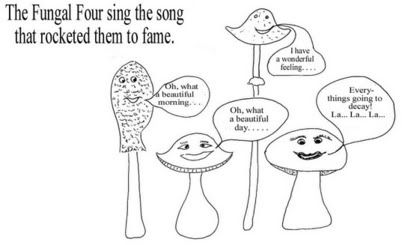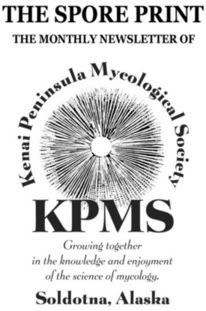Issue 1, November 2005
In this, our first issue of the SPORE PRINT, we would like to thank those who showed such enthusiasm toward the formation of KPMS. Your positive responses were a great encouragement toward our effort. We are confident that you will find this organization a benefit to you as we pursue our interest in ‘mushrooming’ together. Although the study of mycology goes back well over a century, it has only been in the last two or three decades that this discipline has really come into its own. As a consequence, there are tremendous opportunities for the amateur to make significant contributions to the field. Though it may be that your initial interest is in learning to identify a few edible species for the table, we hope that this will be just the starting point in a much broader, life-long study of the fungi.
THE FUNGUS AMONG US
By S. Scott

KPMS is the outgrowth of a recent conversation I had with Dominique Collet. Many of you know him as a diligent and quite knowledgeable student of mycology. When I moved to Soldotna from Montana in the fall of 2004, I made numerous inquiries and was disappointed to find that there was not currently an active mushroom club on the Kenai Peninsula. In Montana I was an avid ‘shroomer and co-founder of the Kootenai Valley Mycological Society (which has been a growing and productive club for about a dozen years). In talking with Dominique, it was soon apparent that he also had a desire to see a local club formed, but was unable to devote the time needed to get one organized. I committed myself to take on some of the organizational responsibilities if he would offer his expertise as the ‘resident mycologist’ for the club. He agreed and KPMS was born. I do not want to neglect to mention Janice Chumley, who many of you know from the Cooperative Extension Office as the ‘bug lady’. She is also an avid amateur mycologist and the one who originally gave me Dominique’s name as a contact. She has agreed to act as the interim secretary and treasurer for the club and help in any way she can.
As with any club, we are drawn together by a common interest. In our case it is an interest in mushrooms. Our goal is to provide a vehicle where we can corporately enjoy this pursuit. We will be organizing walks and forays, providing a setting where all have an opportunity to share their knowledge and experience and offering assistance and instruction to all that desire to learn more.
As a club member, you will have access to the club’s mycology library. You will be able to obtain copies of a large selection of identification charts and keys, instructional materials and a mushroom identification program for your PC, for the cost of duplication! You will also be able to purchase two great field guides (Mushrooms Demystified and All That The Rain Promises And More) at 50% off the bookstore price! Arora’s Mushrooms Demystified is unquestionably the best field guide that is currently available and the mushroomer’s ‘bible’. You will also receive our monthly newsletter, The Spore Print. (At this time The Spore Print is an evolving publication. Its final form is still uncertain, but, at the very least, it will keep you abreast of current club news and events, provide a forum for members to share their insights and experiences, and contain interesting and educational articles with a few quizzes and a little mushroom humor thrown in.)
By S. Scott

KPMS is the outgrowth of a recent conversation I had with Dominique Collet. Many of you know him as a diligent and quite knowledgeable student of mycology. When I moved to Soldotna from Montana in the fall of 2004, I made numerous inquiries and was disappointed to find that there was not currently an active mushroom club on the Kenai Peninsula. In Montana I was an avid ‘shroomer and co-founder of the Kootenai Valley Mycological Society (which has been a growing and productive club for about a dozen years). In talking with Dominique, it was soon apparent that he also had a desire to see a local club formed, but was unable to devote the time needed to get one organized. I committed myself to take on some of the organizational responsibilities if he would offer his expertise as the ‘resident mycologist’ for the club. He agreed and KPMS was born. I do not want to neglect to mention Janice Chumley, who many of you know from the Cooperative Extension Office as the ‘bug lady’. She is also an avid amateur mycologist and the one who originally gave me Dominique’s name as a contact. She has agreed to act as the interim secretary and treasurer for the club and help in any way she can.
As with any club, we are drawn together by a common interest. In our case it is an interest in mushrooms. Our goal is to provide a vehicle where we can corporately enjoy this pursuit. We will be organizing walks and forays, providing a setting where all have an opportunity to share their knowledge and experience and offering assistance and instruction to all that desire to learn more.
As a club member, you will have access to the club’s mycology library. You will be able to obtain copies of a large selection of identification charts and keys, instructional materials and a mushroom identification program for your PC, for the cost of duplication! You will also be able to purchase two great field guides (Mushrooms Demystified and All That The Rain Promises And More) at 50% off the bookstore price! Arora’s Mushrooms Demystified is unquestionably the best field guide that is currently available and the mushroomer’s ‘bible’. You will also receive our monthly newsletter, The Spore Print. (At this time The Spore Print is an evolving publication. Its final form is still uncertain, but, at the very least, it will keep you abreast of current club news and events, provide a forum for members to share their insights and experiences, and contain interesting and educational articles with a few quizzes and a little mushroom humor thrown in.)
A TALE OF THE
MADNESS OF MUSHROOMERS AND THE
BADNESS OF LITTLE MEN
I was out in the woods the other day
In search of the King Bolete.
When, to my surprise, when I plucked up a cap
What should I find at my feet!
It was one of those little leprechauns,
He had been napping under my Cep.
And to his amazement, and mine as well,
I soon had him fast in my grip.
He wiggled and kicked and bit my hand.
His curses, they filled those spruce hills.
In one hand I held that struggling elf,
In the other my fat Stienpilz.
“Listen”, I screamed, “I’m not after your gold,
And I’m not a bully or meany.
I’m only out here for some peace and quiet
And to fill my basket with Porcini!
Now, if you’ll shut up, I’ll let you go.
I’m a man on an Edulis quest!”
But when I sat him down, he kicked my shin,
So, I squashed the obnoxious pest!
By S. Scott
MADNESS OF MUSHROOMERS AND THE
BADNESS OF LITTLE MEN
I was out in the woods the other day
In search of the King Bolete.
When, to my surprise, when I plucked up a cap
What should I find at my feet!
It was one of those little leprechauns,
He had been napping under my Cep.
And to his amazement, and mine as well,
I soon had him fast in my grip.
He wiggled and kicked and bit my hand.
His curses, they filled those spruce hills.
In one hand I held that struggling elf,
In the other my fat Stienpilz.
“Listen”, I screamed, “I’m not after your gold,
And I’m not a bully or meany.
I’m only out here for some peace and quiet
And to fill my basket with Porcini!
Now, if you’ll shut up, I’ll let you go.
I’m a man on an Edulis quest!”
But when I sat him down, he kicked my shin,
So, I squashed the obnoxious pest!
By S. Scott
Our first meeting will be Saturday, December 3rd at 1:00 p.m. at the Cook Inlet Aquaculture Building, 40610 K-Beach Road, Kenai. At that time we will present a more comprehensive explanation of our goals for KPMS and give you an opportunity to ask questions, offer suggestions etc. Dominique will also give a slide presentation of local mushrooms followed by refreshments and a time to get acquainted with one another. We hope to see you there!
Steve Scott
Steve Scott

